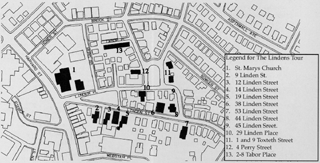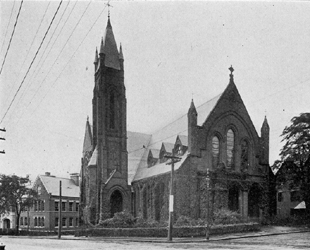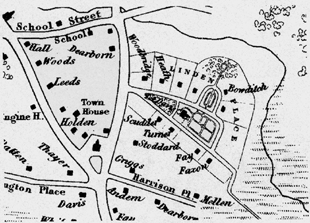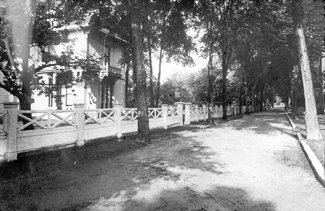Courtesy, Brookline Preservation Commission
Brookline Lyceum near the intersection of Boylston and Washington streets. The first church, built a few years later, stood on Andem Place. In 1873 the land on Harvard Street was purchased by the Catholic church from George Homer for $27,000, and in 1878 the remaining property at the corner of Harvard Street and Linden Place was acquired for an additional $13,400. Although work began on the church in 1880, it was not finished and dedicated until 1886. The architects were Robert S. Peabody and John G. Stearns, both Brookline residents and partners in one of the most important firms in the City of Boston. The exterior is a striking example of Victorian Gothic design in which the nave and free-standing tower are heavily embellished with Gothic arches and tracery expressed in brick. Particularly impressive are the large paneled oak doors. Directly to the right of the church is the rectory, built in 1892 around the original mid-century Homer house and designed by the Brookline architect who also did St. Mary's of the Assumption School, R J.Untersee.
Standing in front of the rectory you will notice on your right a triangular shaped park that is a part of the original development of the Lindens, which was begun by Thomas Aspinwall Davis.
Thomas Aspinwall Davis grew up in his father's house on Kent Street and started to work in a jeweler's shop in Boston at the age of 14. He later started his own business and, through a combination of inheritance and acquisition, obtained title to the Davis farm which included this land. He ran twice for Mayor of Boston before being elected in 1844, only to die in November of the following year. In 1843 he had this land sub-divided into parks and building lots for Brookline's first prestigious suburban development.
An auction notice for the lots which appeared early in 1843 described the advantages of the neighborhood:
The over-all design was apparently the work of a well-known civil engineer, Alexander Wadsworth, and John F. Edwards, an architect-builder who had trained as a house-wright. The original scheme included the triangular park with Davis' house at the end. The house has been moved around the corner to 29 Linden Place (10) but it stood where three triple decker houses are now located on Linden Court. Behind the house the lot extended to Linden Place and was apparently landscaped with gardens.
Perpendicular to this property is a horseshoe park, Linden Square, which was surrounded by house lots. Thus Davis created an estate which included its own residential neighborhood with lots available for purchase by other Boston merchants. By 1844, the year he was elected mayor, eight other houses had been built. Although the neighborhood has undergone major changes, particularly in the density of construction, what remains will be noted along with later additions as you walk around the parks.
The ability of our ancestors to move buildings should never be underestimated and the large mansard style structure at 9 Linden Street [2] is an example for it originally stood at the corner of Harvard Street until it was moved in 1888 in response to pressures of commercial development. Nonetheless, its construction date of the early 1850's allows it to sit comfortably with the earliest houses in the Lindens. The house was built for Isaac Rich, who owned a packet line to New Orleans and exported dried fish to Europe and the West Indies. He became quite wealthy and was a founder of the Boston Theological Seminary, which became Boston University.
The next house is the first of the survivors of Davis' original development, 12 Linden Street [3], built in 1843 for a Boston hardware merchant named Charles W. Scudder. The house is an excellent example of the Greek Revival style in which the front facade of the house suggests a classical temple. Note how the walls are flush-boarded rather than clapboard to suggest the smooth surface of stone. The facade is framed with corner pilasters suggesting columns which support a pediment fabricated out of the gable end. The moldings and proportions of this pediment are derived from classical Greek temples. The verandah running around three sides was built because porches were just coming into fashion at that time. However, it, too, features classical columns supporting a Greek entablature. The original columns were fluted Greek Doric, however. The present Roman Tuscan columns without fluting are recent replacements.
Next to the Scudder House, 14 Linden Street [4], is one of the many apartment blocks built here at the turn-of-the-cen-tury. This one is more ornate than the others and is very elaborate for a "triple-decker". It was constructed in the Colonial Revival style in 1897 for a local contractor named Arthur H. Bailey. The architect was Alonzo G. Brewer, an architect-builder in Brookline who designed a large number of houses on Aspinwall Hill. Many of the same decorations around the windows and entrance to this building can be found on Brewer's houses in the same style.
At 19 Linden Street [5] is another 1843 Greek Revival style house. This one has the flush-boarding only in the gable end and two porches along either side. These porches, however, still retain the original Greek Doric columns. This house was built for John Turner, a partner in a Boston dry goods firm. The reason the front of the house is on the side is because that elevation faces south, which was important in an era without central heating.
Continuing down Linden Street on the right you pass 20th century apartment buildings on the site of the Harrison Fay House, which also included a large landscaped lot with gardens. Opposite at 38 Linden is an apartment block constructed in 1885 and called, "The Linden" (38 Linden Street-[6]). Set back from the street with two and three sided bays windows, this was built with an effort to provide light and air to the units. It also features a facade in the Queen Anne style with ornamentation that enlivens the street.
This brings you to 53 Linden Street [7], one of the finest survivors from the 1843 development. This Greek Revival style house was built for John G. Faxon, who worked for a Boston lumber merchant. The gable end facade of this house has flush-board siding and, because the proportions are more vertical, double pilasters supporting the entablature and pediment. An unusual and very stylish feature for the time is the triple windows which, on the first floor, have a cornice supported on small modillions. Built in the plan of a Greek cross, the house features flanking porches with fluted Ionic columns rather than Doric.
The tour now continues up Linden Place toward Linden Square. The entire block on your left is the site of what used to be the gardens of the Thomas Aspinwall Davis estate. A subsequent owner began to subdivide the property after the Civil War and the house at the corner, 44 Linden Street [8], was constructed in 1874. Two Boston merchants erected this house as a rental property. It is a mansard style structure with sandstone window trim and decorative dormers sometimes referred to a "neo-Grec" for its classical detailing. The porch is a 1923 replacement of what was a more ornate Victorian porch (it appears in right of historic photo of the Fay House). Although not built to be owner-occupied, the house is fairly substantial for its size and suggests that the neighborhood still retained its character of stylish single family homes as late as the 1870s.
At 45 Linden Street [9] is a single family home constructed in an entirely different style. Built in 1888, this house is in the Shingle style, a name derived from the fact that the shingled surfaces comprise all of the ornamentation. The style was especially popular in coastal areas where architects could create all sorts of fanciful treatments-such as the long raking cornice extending down over the circular porch. This house was designed by Obed F. Smith, a Boston architect who designed a great many buildings in Brookline during the 1880s and 1890s. It was built for Clement Fay, who grew up in the now demolished Harrison Fay House.
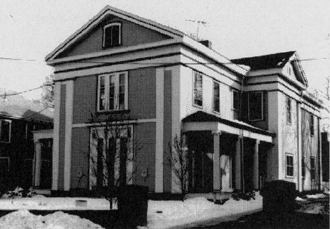
The tour now comes to Linden Square, the second park created in the original 1843 development. Linden Square remained in private hands until 1895 when it was donated to the Town as a public park. There are five houses on its periphery which date from the original development, although two are not on their original sites. One of these, 29 Linden Place ([10], is the home of the original developer of this neighborhood, Thomas Aspinwall Davis. The house was moved from its site at the head of Linden Park in 1903 and it lost its two Gothic porches at that time. The Davis house was apparently designed by John R Edwards, an architect who lived on Harvard Ave. Edwards was clearly aware of the latest architectural designs featured in Cottage Residences, an 1842 publication by Andrew Jackson Downing which, more than any other book, popularized the new picturesque styles for domestic architecture. Gothic features on this house include the hood moldings over the windows and the use of vergeboard in the gable ends. An indication that this house was a very early example of the style is found in the design of the vergeboard elements along the eaves, which are Greek anthemions and not actually Gothic ornament. The porches which originally extended across the front and right side, however, appear to have been based upon a plate in Downing's Cottage Residences. The Davis house as it stood on its original site with its two verandahs, was one of the earliest examples in Boston of the new picturesque and romantic design concepts for country houses.
Two more early Gothic Revival style cottages were built at 1 and 9 Toxteth [11] on the east side of Linden Square. The house at 1 Toxteth has a modern porch with plain posts, but the windows have Gothic hood moldings and Gothic dormers on the roof. Next door at 9 Toxteth is a house which has been extensively altered but retains its Gothic hood moldings under the porch. Both houses were owned by William Ingersoll Bowditch, a Boston businessman who was very active as an abolitionist. Bowditch lived in 9 Toxteth until 1867 when he built a house on Tappan Street. It was about 1849 that two fugitive slaves from South Carolina, William and Ellen Crafts, stayed in this house on their way to Canada. After John Brown's execution, one of his sons also stayed here.
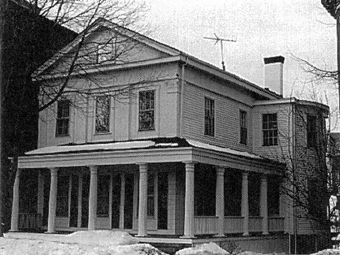
Across Linden Square is 4 Perry Street [12], which stood on the corner lot facing south on Linden Place until 1903 when it was moved to its present location hemmed in by a brick apartment block. Constructed in 1843 for William Wellman, a banker in Boston, this Greek Revival style house is one of the most elegant interpretations of the style in Brookline. The four pilasters which extend across the principal facade are in the Corinthian order, and the porch columns have lotus leaf capitals, a motif derived from Egyptian architecture. Originally the house was symmetrical with the porch extending around both sides and a matching bow window on the south side. The bow fronted parlor or dining room wing on the north side of the house originally faced east toward Linden Square. Behind the house, at 20 Linden Place is a small dwelling which was originally the carriage barn for the Wellman House. A grandson of the original owner, William A. Wellman, born here in 1896, became a famous Hollywood director. Among his credits include, "Wings", the first Oscar-winning Best Picture, "Public Enemy", "The Ox-Bow Incident", and "A Star is Born".
If you continue down Perry Street to Tabor Place there is evidence of the early transition of this neighborhood from single family homes on spacious lots to multi-family units. On the south side of Tabor Place is a row of nine mansard style houses erected in 1875 by a Boston physician named Archibald McDonald. Dr. McDonald lived in a house on the north side of Linden Place which is now demolished. His property extended all the way to Brook Street. The early tenents of this row, originally called "Linden Place Court", included a locksmith, a watchmaker, a brass worker, and two widows. At the time of their construction the population density was still not great and this row was probably considered to be an unusual and progressive concept in terms of providing a healthy environment for people of moderate means. The brick apartment block on the opposite side was built in 1895 and reflects more of an urban concept of multi-family dwellings. Where the mansard row is set back from the street and features small porches, the brick block completely fills the lot right up to the sidewalk, creating an imposing presence on this small street. Thus Tabor Place provides a contrast between Linden Place as it was originally conceived and how it changed before the end of the nineteenth century.
Originally prepared and printed in 1986 by Carla Benka, Greer Hardwicke, and Leslie Larson, edited and reformated in 1996 by Roger Reed and Greer Hardwicke, funded through the Community Development Block Grant Program of the Department of Housing and Urban Development.
